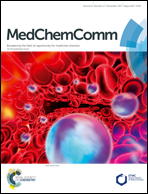Identification of novel N-acetylcysteine derivatives for the treatment of hepatocellular injury
Abstract
New anti-hepatocellular injury drugs with better curative effects and fewer side effects are urgently needed at present. In this study, a series of novel N-acetylcysteine (NAC) derivatives were designed, synthesized and biologically evaluated for their anti-hepatocellular injury activities against two different cell models. In the biological evaluation against hydrogen peroxide (H2O2)-induced LO2 hepatocytes, half of the target compounds exhibited moderate to potent activities in improving the model cell viability, and two compounds (6a and 6b) displayed more potent activities in decreasing malondialdehyde (MDA) levels than the positive control NAC. In further 4-acetamidophenol (APAP)-induced LO2 cell experiment, compounds 6a and 6b could not only improve the cell viability but also significantly reduce the secretion of MDA. Additionally, compound 6a displayed excellent Caco-2 permeability and oral bioavailability in rats. All these experimental results suggested that compounds 6a and 6b could serve as potential lead molecules for further development of anti-hepatocellular injury drugs.



 Please wait while we load your content...
Please wait while we load your content...